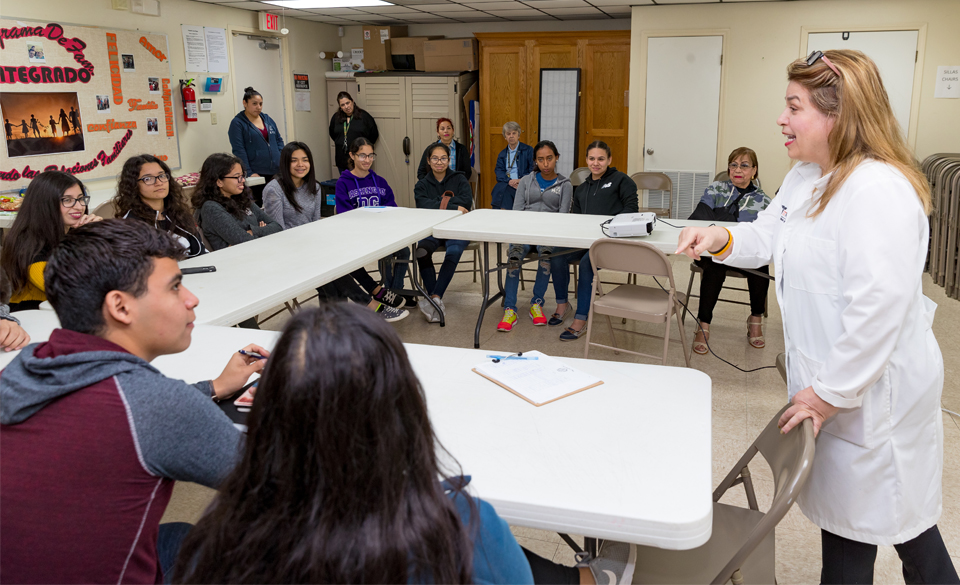University professor hoping program brings attention to brain health
Wednesday, April 3, 2019
Community
By Maria Elena Hernandez
RIO GRANDE VALLEY, TEXAS – Among the senior citizen visitors and vendors at a recent Winter Texan event in Alamo, a small group of high school students line-dancing looked a little out of place.
“We’re just thinking about the song ‘Copperhead Road’ for no reason. And so we’re doing the dance,” said Ashley Caldera, a student at South Texas Academy for Medical Professions.
Though it was spur of the moment, the dance helped the students with their goal that day. They’re the Alzheimer's Ambassadors, a group of high school students working with the Alzheimer´s Disease Resource Center for Minority Aging Research (AD-RCMAR) at The University of Texas Rio Grande Valley.
Alzheimer's disease is a form of dementia that causes changes in memory, attention and behavior. The students were at the Winter Texan expo to raise awareness of the disease and provide resources about prevention and treatment.
The impromptu dance not only helped students get attention, but also let them share an easy way to stay active: Regular physical exercise is one activity that can help lower the risk of Alzheimer's.

YOUTH: UNEXPECTED VOICES FOR AWARENESS
Dr. Gladys Maestre, a UTRGV professor of neuroscience and human genetics and director of the UTRGV Alzheimer’s Disease Resource Center for Minority Aging Research, said the center provides education, mentoring and support for the ambassadors, “so they can become the voice of people with Alzheimer’s and their caregivers.”
Alzheimer’s Ambassadors include students from The Science Academy of South Texas in Mercedes, South Texas Academy for Medical Professions in Olmito, and Saint Joseph Academy in Brownsville. The group’s youth and message are an unexpected combination.
“For the public, they get very surprised to have a young person being more knowledgeable than they are,” Maestre said.
Caldera said they are gaining knowledge and experience with each visit as ambassadors.
“We're learning about neurology,” she said. “And we’re learning about patient care, which is very important in the health field.”
The ambassadors sometimes are asked what college they attend.
“They’re like, ‘Wow, you’re high school students,’” Caldera said.
PERSONAL EXPERIENCES
Caldera was invited to join the group by her friend and classmate Sofi Homes, whose own experiences started her search for resources for people diagnosed with Alzheimer’s and their caregivers.
“My grandpa,” Homes acknowledged. “When we were at the library and there was nothing for anyone with dementia at all, it made him feel alone. And I’m sure there are many other patients here that feel that way, as well.”
Everyone ambassadors have spoken with about the program has been supportive.
“I know some people are scared about getting information on it, because I know that sometimes reality is really hard to confront,” she said. “But besides that, everyone's really open about it.”
STIGMA
The director of the UTRGV Alzheimer’s center said she hopes the positive response to the ambassadors will help fight the stigma that still surrounds the disease.
“Many people would say it’s easier to say my dad or my grandpa has Parkinson’s disease, for example, than to say he has Alzheimer’s disease,” Maestre said, “so we want to provide opportunities for people to talk openly about it.”
Samantha Woo, one of the Alzheimer’s Ambassadors, experienced her own hesitancy to talk about the disease.
“Before the program, I knew about Alzheimer’s because I know people with Alzheimer’s,” she said. “But I didn’t know what it was. It was just there. It was like an elephant in the room.”
HIGHER VULNERABILITY AMONG HISPANICS
Talking openly about the disease may be especially important for Hispanics, Maestre said.
“In cities where they have studied, in the same neighborhood, Hispanics, African-Americans and Caucasians, the percentage of Hispanics with Alzheimer’s is 50 percent more. And it’s not only more; it begins seven years earlier.
“We don't understand the higher vulnerability of the Hispanics. But we are at higher risk.”
Another factor increasing the risk of developing Alzheimer’s disease is family history.
As an Alzheimer's Ambassador, Sergio Gonzalez, a student at Saint Joseph Academy, is well aware of this.
“My family does have a history of Alzheimer’s, so I'm here with the program, trying to learn as much as I can, as well as distributing information,” he said.
FOCUS ON BRAIN HEALTH
It’s this active pursuit of information Maestre hopes the entire community will adopt.
“We want people to think, ‘I need to pay attention to my brain health,’” she said.
She also hopes the Alzheimer’s Ambassadors will expand to include middle school students, and that discussion of brain health will start even earlier.
“I think we need to talk about brain health from kindergarten,” she said. “We have massive opportunities – because of the resources that UTRGV is bringing, and the opportunities that the generosity of the people of the Valley are putting together.”
MORE ABOUT DR. MAESTRE AND HER WORK: https://tinyurl.com/y4ucfhr8
ABOUT UTRGV
The University of Texas Rio Grande Valley (UTRGV) was created by the Texas Legislature in 2013 as the first major public university of the 21st century in Texas. This transformative initiative provided the opportunity to expand educational opportunities in the Rio Grande Valley, including a new School of Medicine and a School of Podiatry, and made it possible for residents of the region to benefit from the Permanent University Fund – a public endowment contributing support to the University of Texas System and other institutions.
UTRGV has campuses and off-campus research and teaching sites throughout the Rio Grande Valley including Brownsville (formerly The University of Texas at Brownsville campus), Edinburg (formerly The University of Texas-Pan American campus), Harlingen, Weslaco, McAllen, Port Isabel, Rio Grande City and South Padre Island. UTRGV, a comprehensive academic institution, enrolled its first class in the fall of 2015; the School of Medicine welcomed its first class in the summer of 2016, and the School of Podiatric Medicine in the fall of 2022.
